RUST BELT IN WEST VIRGINIA
INDUSTRIAL KANAWHA VALLEY PHOTOS
Detail of the LaBelle Nail plant.
Another manufacturing concern in Parkersburg was the Baldwin Tool Works, built in 1910. In 1931 or '32 this plant became the Ames Co. shovel factory. This factory operated into the 21st Century, even after a merger with True Temper.
This June 1956 Pittsburgh Post-Gazette article titled "Fabulous Plants Dot Ohio River System" illustrates a different, more prosperous, more optimistic era:
"Fabulous is the word for the industrial development going on in the Ohio Valley - on the Ohio River and most of its tributaries ... Huge sums for atomic development are included in these totals - nearly a billion dollars at
Paducah, Kentucky; a billion and a quarter near Portsmouth, Ohio; half a billion at Oak Ridge, Tennessee; seventy-four million at Fernald, Ohio; fifty million at Shippingport, near Beaver, this latter a Duquesne Light atmoic
power plant. Time was when steel and coal made up a dual monarchy that occupied the industrial throne in the valleys of the Ohio and its tributaries. This is not true today. There still is steel, still coal - both large scale,
both now in process of big expansion - but there is now in the area a diversification that covers virtually every field of industrial activity. Aluminum, which had its industrial birth in the area on the Allegheny at New Kensington
under the Alcoa banner, and which is now in what is perhaps its greatest expansive mood, has turned heavily to the Ohio Valley, mostly below Pittsburgh. Two great plants, representing capital investment of about $350,000,000, are going
up. One is in Ohio just below Clarington, almost opposite New Martinsville, W.Va. The other is in West Virginia, a few miles below Ravenswood ... A real giant of the Ohio Valley development is the chemical industry. Many new plants
have been built in the past few years by the major chemical companies and several multi-million dollar expansion programs are planned or are being carried out below Moundsville ..."

Feb. 2007 image by author
Perhaps West Virginia's quintessential Rust Belt, located in
the old Cleveland-Pittsburgh steel belt, town is Weirton. One of the main products of Weirton Steel has been tin plated steel. Empty parking
lots in this photo are indicative of a workforce that has shrunk from about 12,000 employees to 1,200 or less.

Feb. 2007 image by author
Weirton Steel was part of National Steel until 1983. In the middle of the collapse of the American steel industry National Steel
offered to sell the company to its employees, and the employees accepted the offer. The company soldiered on through good and bad years for the next two decades until it was purchased
in 2003 by International Steel Group, who in turn was absorbed into Mittall Steel. Sadly, Mittall shut down the hot end of the mill, and now the blast furnaces have gone cold, as shown in this picture. In the fall
of 2007 demolition of these furnaces by Arcelor-Mittal had begun.

Feb. 2007 image by author
View of blast furnaces and steel mill in Weirton from up on the hill.

Feb. 2007 image by author
The mill continues on toward the downtown section of Weirton. Pictured here is the building containing the unused Basic Oygen Furnace.

Feb. 2007 image by author
Wires crossing Route 2 at the steel mill in Weirton.

Feb. 2007 image by author
Detail of the Weirton mill showing an International Steel Group sign.

Feb. 2007 image by author
No. 9 Tandem Mill.

Image source lost
Weirton Steel at its peak in the 1950's.

Mar. 2006 image by author
This coke plant at Follansbee, WV was originally owned by Wheeling-Pittsburgh Steel Co. and later operated as
Mountain State Carbon. This coke plant outlasted all of Wheeling-Pittsburgh's other plants in the Upper Ohio Valley when it closed in 2022.
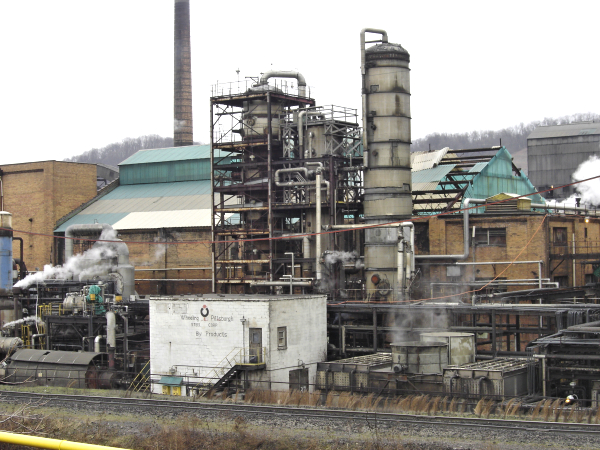
Mar. 2006 image by author
Another view of the coke plant at Follansbee.

Mar. 2006 image by author
All of this plumbing was required to capture the by-products of coke. The old industrial fixture Koppers
Company was involved in this aspect of the Follansbee coke plant.
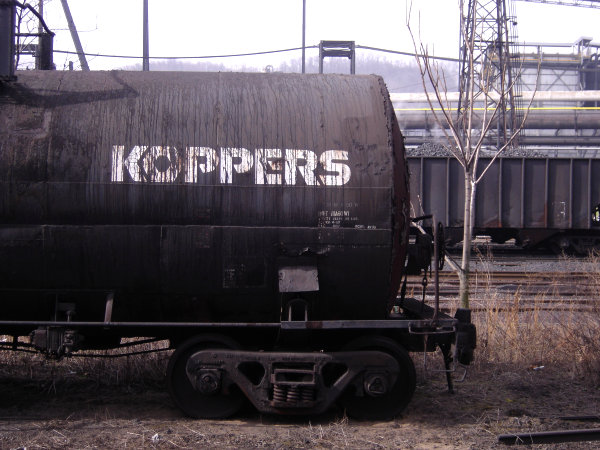
Mar. 2006 image by author
A Koppers rail car to haul the by-products captured from the coke. In the background is a train car full of hot coke.
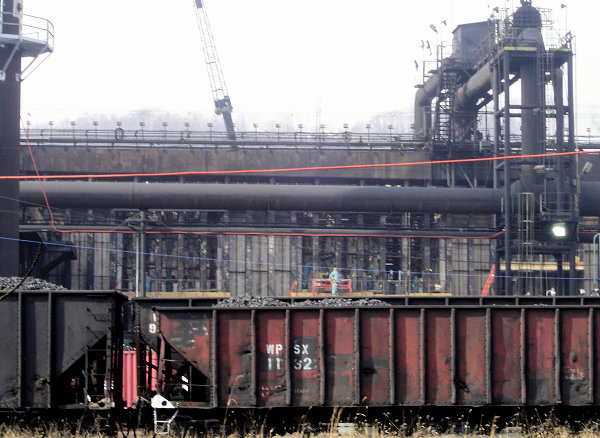
Mar. 2006 image by author
In the middle of this photo you can see an employee working at the coke ovens in his green flame resistant clothes. The rail car marked
WPSX was actually property of Wheeling-Pittsburgh Steel Co.

Mar. 2006 image by author
Hot coke sits smoking in gondola cars in March 2006 before being shipped across the river to Wheeling-Pittsburgh Steel Company's blast furnace at Mingo Junction, Ohio.
W-P also had recently constructed an electric furnace at Mingo Junction. Sadly, Wheeling-Pittsburgh Steel Corp. is now history

Mar. 2006 image by author
View of the Follansbee coke plant from the southern end of the operation.

Mar. 2006 image by author
Despite the aroma from the coke ovens, Follansbee is a pleasant town with a large Italian-American population and well kept
homes such as these.
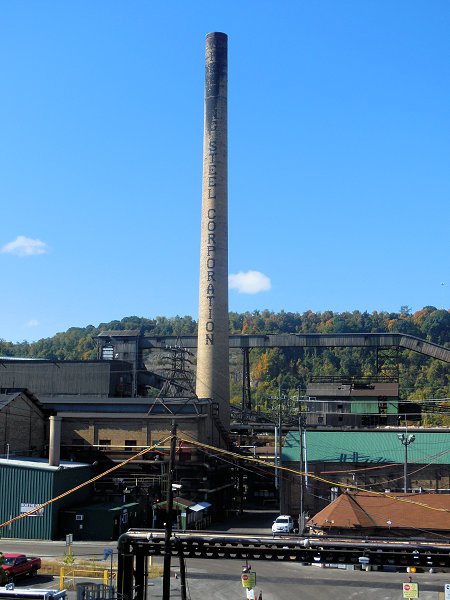
Sep. 2022 image by author
Many years later, I was passed right by the idled coke plant and thought I should pull over and take a photo of it for posterity. I will be really surprised if
it ever reopens.

Image by others
Inside the empty former Wheeling-Pittsburgh Steel Co. sheeting plant at Beech Bottom, W.Va.

Oct. 2006 image by author
The old Wheeling Steel Ackermann Plant in Warwood, WV. Later it was operated by Blaw-Knox.
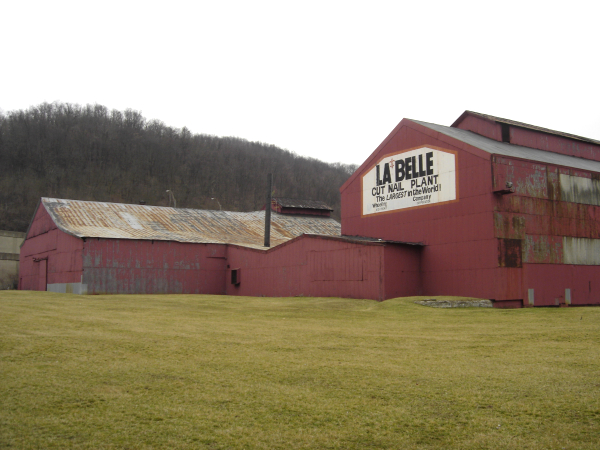
Mar. 2006 image by author
The LaBelle Nail plant in South Wheeling, WV billed itself as the largest cut nail plant in the world. It was built in 1852, and closed down in 2010. When it shut down the
Wheeling Intelligencer quoted a LaBelle employee as saying, "My father worked there for 40 years, and I worked there for 37. It's sad to see it go. Now, here I am at 58 years old trying to start over." This
gentleman also noted, "There was just so much foreign competition. Now, there were plants in China and (South) Korea that took some of our largest customers."

Mar. 2006 image by author

Mar. 2006 image by author
The back side of the LaBelle Nail plant.

Jan. 2006 image by author
The cathedral of the Wheeling-Charleston Diocese in Wheeling, WV. Wheeling is the Catholic capitol of West Virginia due to the large number of Irish, Polish, Italian,
and other European immigrants that came to this city.

Oct. 2013 image by author
Upper Ohio River Valley community of Benwood.

Jan. 2006 image by author
Remnants of the old Wheeling Steel pipe mill in Benwood, WV. In the background is the dangerous and dilapidated former toll bridge between Benwood and Bellaire, Ohio.

Jan. 2006 image by author
Another view of the remnants of the Benwood pipe mill. The first steel pipe in America was manufactured in 1888 at Benwood, although not necessarily at this plant.

Jan. 2009 image by Willy Nelson
The sad looking remains of the Fostoria glass factory in Moundsville, W.Va. It closed in 1986.

Sep. 2006 image by author
Clarksburg, WV is a classic Rust Belt town that is also home to the West Virginia Italian Festival.

Sep. 2006 image by author
Disconnected smokestacks echo the lost industrial greatness of Clarksburg.

Dec. 2007 image by author
UCAR carbon plant in the Annmore section of Clarksburg.

Feb. 2009 image by author
Factory and store of Fenton Art Glass in Williamstown, WV. Fenton has made glass in Williamstown since 1907. This plant announced
plans to shut down in 2007. However, collectors responded to the announcement with a flurry of purchases, and the plant was able to stay open. But in 2011 the company announced another closure,
with the company president stating, "The market for our pressed and blown glassware has diminished. We cannot sustain the overhead costs." The plant still produced industrial glass and glass beads, though.
Recently US Glass, Inc. acquired the facility and plans to make it more sustainable and viable.

Jan. 2014 image by Mike Tewkesbury
The Johns Manville Glass Fiber Manufacturing plant operated in Vienna, W.Va. from 1908 until 2006. The plant has since been demolished and all asbestos properly disposed.

wvbrownfields.org image
This industrial relic in Parkersburg was once the Vitro Agate marble factory.
United Steelworkers of America Local 1651 represented the workers. By 2005 Ames was asking the workers of the Parkersburg plant to accept a 58% reduction in wages, as well as reductions to benefits and holidays. The union said "no," and the plant was closed. Production moved from
West Virginia to Mexico and China, prompting one newly-unemployed ex-Ames employee to quip, "America's workers are dead in the water at any price. Let's hope WalMart opens up some bigger stores, because there are no jobs." The factory itself
burned down in 2017.

May 2008 image by author
In 1957, at the height of America's industrial might, Kaiser Aluminum constructed this aluminum mill near Ravenswood, WV.
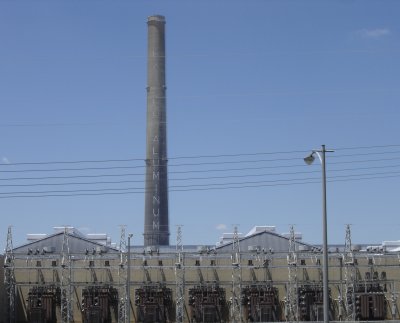
May 2008 image by author
Detail of Ravenswood Aluminum Mill. In 2008, when I took this picture, the plant was operated by Century Aluminum and appeared to be running full speed ahead. Yet less than a
year later, Century laid off 651 employees and shut the plant down.
The adjacent but separated company at this site, Alcan Rolled Products, continued to produce, and was later operated by Constellium. In 2012 700 members of United Steelworkers Local 5668 went on strike at the Constellium plant over workers' health insurance benefits.
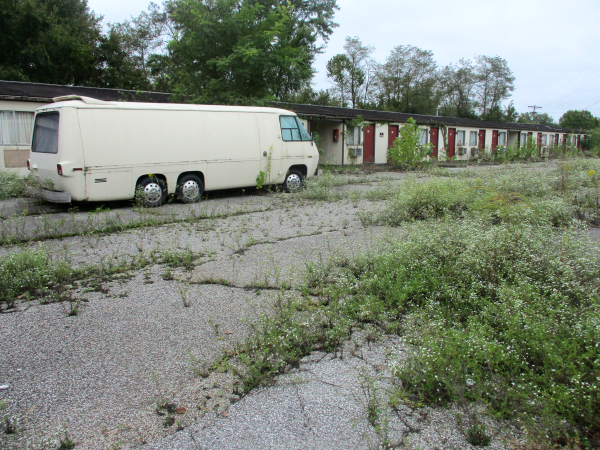
October 2018 image by author
Abandoned "Scottish Inn" hotel near Ravenswood. The sign said the rooms were only $49 per night.

Mar. 2006 image by author
CSX railroad trestle in Guyandotte, Cabell County, WV.

Mar. 2006 image by author
This is the Huntington Alloys works of the Special Metals Corporation in Guyandotte, near Huntington, WV. It was built in 1922 as a nickel alloy mill operated by
the International Nickel Company.

Mar. 2006 image by author
View of the Special Metals plant in Guyandotte, WV.

Mar. 2006 image by author
Another picture of the Special Metals alloy plant - note the internal rails for transporting materials around the plant.

Mar. 2006 image by author
This photograph shows another perspective of the Special Metals plant. I believe that there has been quite a lot of R&D performed at this facility over the years.

Mar. 2006 image by author
Ventillation stacks at Special Metals Huntington Alloys plant.

Mar. 2006 image by author
The Huntington plant of American Car and Foundry (ACF) built "covered hopper cars," Center-Flow cars, and other kinds of rail cars for over 100 years. Most of this is gone now.

Mar. 2006 image by author
Shops of ACF Industries in Huntington. The facility once employed 1,600 workers, and around 400 as late as the 1990s, but the Huntington Herald-Dispactch reported in 2010 that there
were four workers remaining - and three were security guards. The newspaper also noted that, although the plant once built 28 Center-Flow rail cars a day, "...by 2001, the market for the Center-Flow cars had dried up and most of the plant s workers had been furloughed.
The few that remained mostly made wheel pairs for tank cars manufactured at ACF s plant in Pennsylvania. Now, even that work apparently has come to a halt." (Mar. 2006 image by author)

Mar. 2006 image by author
Warehouse district in Huntington, WV.

Mar. 2006 image by author
A portion of Steel of West Virginia's mill in Huntington, WV.

Mar. 2006 image by author
Steel of West Virginia began operations in 1909.

Mar. 2006 image by author
As illustrated by the heap of scrap metal in the background, Steel of West Virginia is a "mini-mill" of sorts.

Aug. 2009 image by author
Steel of West Virginia as seen from across Third Avenue in Huntington.

Mar. 2006 image by author
Norfolk-Southern railroad trestle in Ceredo, WV.